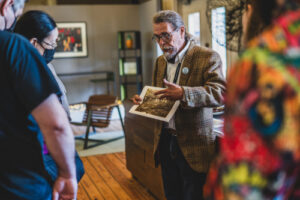 Name: Martina D. Reilly, AIA LEED AP BD+C
Name: Martina D. Reilly, AIA LEED AP BD+C
CivicLAB Class: 2012
Alma Mater: University of Maryland, College Park
Hometown: Bowie, Maryland
Why was it important for you to take part in CivicLAB?
I have always been passionate about social justice and how architecture can positively influence social sustainability. I was encouraged to participate in the program by a principal at my firm to learn more about how architects can make a difference in their communities through the built environment. I saw it as a great networking opportunity where I can hone my leadership skills and learn more about the intersection of architecture in politics, policy, and people.
Since participating in CivicLAB what new leadership opportunities have you discovered?
Participating in CivicLAB inspired me to become active in disaster response and resilient design. Shortly after I participated in the program, I worked with AIABaltimore to apply for and win a grant to develop a Disaster Assistance Program for architects in Maryland. Since then, we have trained over 30 architects in the state to do rapid assessments in the event of a disaster. Through my work with the Disaster Assistance program, I partnered with AIABaltimore COTE to form the current COTE + Resiliency Committee. We have held many programs over the years, including the B|MORE Resilient Rowhouse Design Competition and partnering with Morgan State Architecture Studios to teach students about resilient design. I currently work with AIA National on the Resilient Education Working Group to develop coursework for architects to learn more about resilient design.
How can architects/designers become better advocates for the profession and the built environment?
The first step is caring about advocating—thinking outside of one’s own self, one’s own projects and clients, and thinking about how what we do can really help other people. The next step is walking the walk—getting involved with local advocacy groups including Political Action Committees, attending community meetings in the areas in which we design, and volunteering for community charrettes. It is important to hear what other people want, distill those wants and needs into our designs, and use our designs to advocate for more good architecture; providing proof to our clients and politicians that design matters. A case study of a good, successful design is the best kind of evidence to show how small moves can make a big impact.
What makes this an exciting time to be a Citizen Architect in Baltimore?
There is so much potential and opportunity in Baltimore; we have an amazing historic fabric, access to waterfront, and good energy towards making the city a more sustainable place. I see a lot of opportunity in the city’s stock of vacant and unused buildings that are waiting to be re-imagined as new development. With opportunity comes great responsibility and a need for advocacy. It is so important to embrace the communities in each new development and find ways to bring people in and not push people out. I believe inclusive, socially conscious design can make a big difference in Baltimore—it can help reduce crime, improve health, and strengthen the sustainability of our neighborhoods. There is a lot a citizen architect can do to help advocate for good design, including doing great design!
Any hobbies outside of leadership, advocacy, architecture?
I enjoy board games and hope to one day go into board game design. I also enjoy reading and writing and hope to write a book one day.
Interested in participating in CivicLAB? Applications are open through February 2! http://www.aiabaltimore.org/civiclab-2018/
CivicLAB Spotlight: Martina Reilly, AIA LEED AP BD+C
Latest Member News

March 5, 2024 / Member News
Hord Coplan Macht Principal Appointed as First Black Chair to Maryland State Board of Architects

December 19, 2023 / Member News
Baltimore Architecture Foundation’s 2023 Year in Review